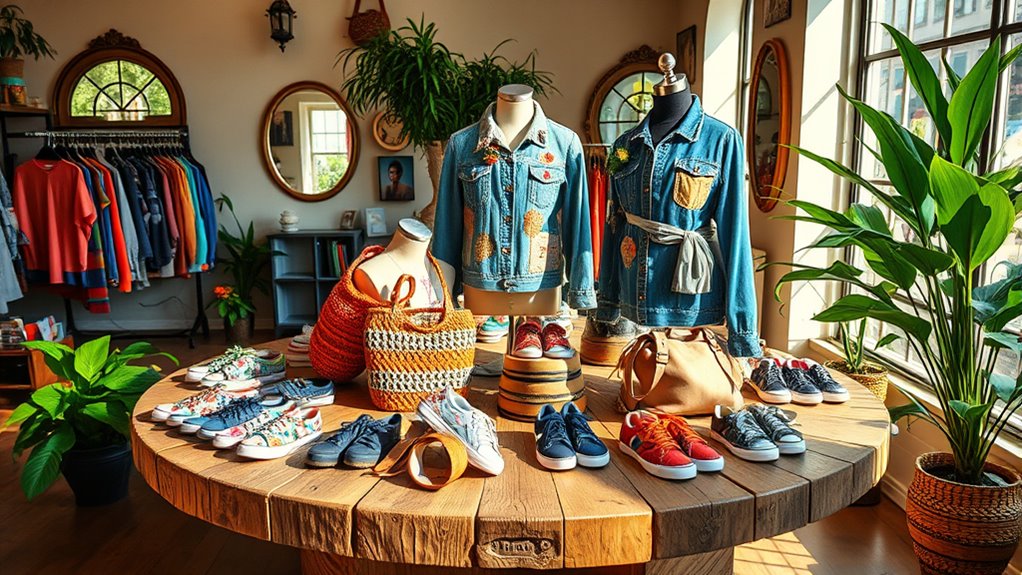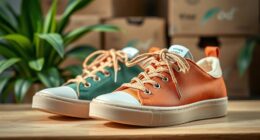Circular fashion is reshaping how you think about clothing by emphasizing recycling and upcycling to make sustainability stylish. Designers focus on creating versatile, durable garments that can be transformed or reused easily, reducing waste and conserving resources. Brands now offer take-back and recycling programs to keep clothes in circulation longer. By embracing these trends, you’re supporting a responsible industry that values innovation and environmental health. Keep exploring to discover how these practices are transforming fashion for good.
Key Takeaways
- Recycling transforms old garments into new textiles, reducing waste and conserving resources in fashion production.
- Upcycling creatively repurposes existing materials into unique, high-value fashion pieces, promoting sustainability.
- Brands implement take-back and recycling programs to facilitate closed-loop systems and extend product lifecycle.
- Innovative designs focus on modularity and repairability, encouraging consumers to reuse and upcycle garments.
- Growing consumer demand for eco-friendly options drives industry adoption of recycling and upcycling trends.

Sustainable materials are the backbone of circular fashion. Instead of relying on conventional fabrics that deplete resources or pollute the environment, designers now opt for eco-friendly options like organic cotton, hemp, recycled polyester, or even textiles made from discarded plastic bottles. These materials lessen the demand for new resource extraction and lower carbon footprints. Furthermore, they often come with certifications that guarantee their sustainability, giving you confidence that your wardrobe choices support greener practices. By integrating sustainable materials, brands show that fashion doesn’t have to harm the planet; instead, it can actively participate in conservation. Incorporating vertical storage solutions and multi-functional furniture into your wardrobe organization can help accommodate these eco-friendly pieces more efficiently. Design innovation plays a vital role in making circular fashion feasible and appealing. Forward-thinking designers craft garments with versatility, durability, and ease of repair in mind. They create clothing that can be easily upcycled or transformed into new pieces, encouraging a mindset shift from disposability to longevity. For example, modular designs allow you to mix and match components, giving you multiple looks from a single item. Some brands even develop clothing with embedded recycling instructions or features that simplify disassembly, so your garments can be recycled into new textiles when they reach the end of their life. This focus on innovation ensures that circular fashion isn’t just a trend but a sustainable paradigm that keeps evolving. When you support brands dedicated to circularity, you’re endorsing a system that values resourcefulness and creativity. These companies often incorporate recycling programs, take-back schemes, or repair services, making it easier for you to participate in a closed-loop cycle. The goal is to design clothes that can be broken down and repurposed repeatedly, reducing landfill waste and conserving natural resources. As consumers become more conscious, the demand for such innovative, sustainable options grows, pushing the entire industry toward more responsible practices. In essence, circular fashion isn’t just about recycling your old clothes; it’s about redefining how fashion is created, worn, and disposed of. By embracing sustainable materials and design innovation, you help foster a system where fashion becomes a force for good—less wasteful, more creative, and ultimately more sustainable.
Frequently Asked Questions
How Does Circular Fashion Impact Global Textile Waste?
Circular fashion substantially reduces global textile waste by promoting recycling and upcycling, which minimizes textile pollution. When you choose circular options, you help cut down on waste, extend the life of clothing, and reduce the environmental footprint of the fashion industry. Your support for sustainable practices encourages waste reduction, making a positive impact on the planet and helping to combat the growing problem of textile pollution worldwide.
What Materials Are Most Commonly Recycled in Circular Fashion?
Like a modern-day Da Vinci with a smartphone, you should know that cotton, polyester, and wool are most commonly recycled in circular fashion. Material recovery involves breaking down textiles through recycling processes, transforming old fabric into new materials. Polyester, especially from plastic bottles, is highly recyclable and prevalent. Cotton and wool are also recovered, reducing waste and conserving resources, making your fashion choices more sustainable and eco-friendly.
How Can Consumers Identify Truly Sustainable Upcycled Clothing?
You can spot truly sustainable upcycled clothing by checking for eco-friendly dyes and ethical sourcing labels. Look for brands transparent about their processes, ensuring the materials were upcycled responsibly. Certifications or detailed product descriptions often indicate the use of eco-friendly dyes and ethical sourcing. When shopping, ask questions or research online to confirm the brand’s commitment to sustainability, helping you make eco-conscious choices that support circular fashion.
What Are the Economic Benefits of Adopting Circular Fashion Practices?
By adopting circular fashion practices, you can boost economic growth and support job creation in sustainable industries. These practices encourage innovative design and recycling, leading to new business opportunities and increased demand for eco-friendly materials. When you choose brands committed to circularity, you’re helping to stimulate local economies, create jobs in recycling and upcycling sectors, and promote a more resilient, sustainable fashion industry that benefits everyone involved.
How Do Circular Fashion Initiatives Influence Fashion Industry Innovation?
You see, circular fashion initiatives drive innovation by encouraging designer collaborations that push sustainability boundaries. They inspire brands to develop circular supply chains, making production more efficient and eco-friendly. This proactive approach fosters new materials, techniques, and business models, giving you fresh, sustainable options. Ultimately, these initiatives challenge industry norms, leading to groundbreaking ideas that blend style with environmental responsibility, which benefits both creators and consumers alike.
Conclusion
As you embrace circular fashion, remember that you’re part of a larger story—like the phoenix rising from its ashes, your choices breathe new life into old materials. Recycling and upcycling aren’t just trends; they’re a revolution echoing through time, shaping a more sustainable future. By choosing this path, you become a chapter in the ongoing tale of renewal, proving that beauty and purpose can emerge from what once was forgotten.









